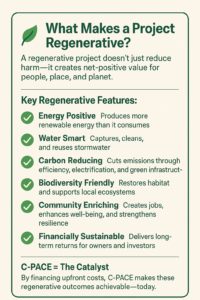C-PACE as Regenerative Development Financing

Image by Gerd Altmann from Pixabay
In the face of rising energy costs and the need to address increasing environmental hazards, sustainability is no longer optional but essential. Retooling and rebuilding our infrastructure is part of the new reality, and the goal should be to make it as enduring and regenerative as possible. The availability of regenerative development financing emerges as a powerful catalyst for positive change.

At its core, regenerative development financing goes beyond traditional funding models by not only minimizing harm but also actively restoring and enhancing ecological, social, and economic systems.
Commercial Property Assessed Clean Energy (C-PACE), as implemented through NY’s Sustainable Energy Loan Program or NJ’s Garden State C-PACE Program, exemplifies this approach. Far more than a simple financial tool, C-PACE provides property owners and developers with long-term, fixed-rate financing for energy efficiency upgrades, renewable energy installations, and in some case resiliency measures—all without upfront costs. This innovative mechanism attaches to the property as a special assessment, making it transferable upon sale and non-recourse to the owner.
What if financing your next project could do more than boost ROI—what if it could regenerate your community? That’s the promise of C-PACE financing. While many see C-PACE as simply another tool in the capital stack, it can be much more: a catalyst for regenerative community development.
What sets C-PACE apart as regenerative is its potential to create ripple effects of positive community impact. By funding projects that reduce emissions, conserve resources, and build resilience against climate challenges, C-PACE transforms buildings into assets that give back to their surroundings, fostering healthier environments and stronger local economies. Regenerative financing goes beyond minimizing harm. It’s about channeling capital into projects that actively restore, revitalize, and future-proof our communities.
The Regenerative Lens in Property Development
Viewing property development through a regenerative lens means designing spaces that heal rather than deplete. C-PACE enables this by unlocking capital for innovative, sustainable building approaches that might otherwise be financially out of reach. For instance, developers can secure up to 35% of their capital stack for new construction or gut rehabilitations at lower costs and better terms, funding everything from solar arrays and geothermal systems to floodproofing and water conservation technologies.
This financing doesn’t just support green retrofits; it drives ecological restoration on a broader scale. Imagine a commercial building that not only achieves net-zero energy but also incorporates green infrastructure to restore local watersheds or biodiversity. Through C-PACE, such visions become reality, e.g., aligning with New Jersey’s ambitious goals to slash building emissions by 85% by 2050 and upgrade 20,000 commercial structures by 2030. By integrating regenerative principles, C-PACE turns development into a force for environmental renewal, proving that smart financing can regenerate ecosystems while delivering strong returns.
Looking at projects through a regenerative lens means asking: How can this building give back more than it takes? By aligning private development with ecological and social priorities, C-PACE turns financing into a tool for systemic innovation.
When C-PACE is used to pursue regenerative goals, the ripple effects extend far beyond the property line:
- Job Creation: Energy efficiency and renewable energy projects employ local workers, strengthening the regional economy.
- Environmental Health: Better buildings mean cleaner air, reduced carbon emissions, and stormwater solutions that restore ecological balance.
- Architectural Leadership: Forward-thinking projects inspire others, raising the bar for what’
- s possible in sustainable and regenerative design.
The result is not just a better building, but a stronger, more resilient community.
Community Benefits of Regenerative Development
The true power of regenerative development lies in its community-wide benefits, where individual projects contribute to collective well-being. C-PACE-funded initiatives create high-quality jobs in construction, engineering, and clean energy sectors, stimulating local economies and providing opportunities for skilled workers. These projects often prioritize resilient designs that restore environmental health, such as reducing urban heat islands through green roofs or mitigating flood risks in vulnerable areas.
Moreover, regenerative development inspires forward-thinking architectural practices that prioritize human and planetary health. Buildings become community hubs—think multifamily housing with energy-efficient systems that lower utility bills for residents or industrial facilities that incorporate regenerative agriculture elements. In New Jersey, where climate resilience is critical, C-PACE supports these efforts by financing measures that protect against storms and conserve water, ultimately building more equitable and thriving communities. This should also be added to New York’s law.
Case for Early Adopters
For forward-thinking developers and architects, C-PACE represents a prime opportunity to lead the charge in regenerative development. Early adopters can differentiate themselves in a competitive market by showcasing projects that embody innovation and responsibility. With access to affordable, long-term financing, these pioneers can tackle ambitious designs that blend cutting-edge sustainability with economic viability, setting new standards for the industry.
The long-term advantages are compelling: enhanced property values, reduced operating costs through energy savings, and alignment with growing investor demand for ESG (Environmental, Social, and Governance) criteria. In a state like New Jersey, where clean energy transitions are accelerating, early movers position themselves for grants, tax credits, and partnerships that amplify their impact. By embracing C-PACE now, developers not only future-proof their portfolios but also contribute to a legacy of regeneration that benefits generations to come.
Call to Action
The time to embrace regenerative financing is now. Developers, architects, and property owners in New York and New Jersey: explore how C-PACE can transform your next project into a beacon of sustainability and innovation. Whether you’re retrofitting an existing building or breaking ground on something new, this tool offers the financial flexibility to make regenerative dreams a reality.
Ready to get started? Contact us for a personalized consultation. Reach out today to learn how we can help you harness the power of C-PACE for a brighter, more regenerative future. Together, let’s build a region that thrives.
If you’re a developer, property owner, architect, or municipal leader, now is the time to explore how regenerative financing can work for you. We are here to guide you through the process and help unlock the full potential of your projects.
👉 Contact us today to learn how C-PACE can transform your vision into a regenerative reality.
And thanks to Dr. Margot Fass for documenting these examples:
C-PACE has been used around the U.S. to fund resilience measures that address flooding, drought, and storm risk. Here are concrete examples and where they’ve been done:
In Connecticut, the Corbin District redevelopment in Darien became the state’s first C-PACE project to include explicit resiliency measures, notably stormwater management (permeable paving and related site work). It received a record $63 million in C-PACE financing and was named the Green Bank’s 2024 C-PACE Outstanding Project of the Year. (Source: CT Insider)
Detroit has used PACE to finance green roofs—counted as green stormwater infrastructure—providing on-site stormwater detention that reduces flooding and sewer overflows while delivering energy and heat-island benefits. (Source: Counterpointe Sustainable Real Estate)
Florida’s PACE statute explicitly authorizes “hurricane hardening” improvements (e.g., impact windows, roof reinforcement), and programs there regularly finance wind-resilience upgrades that reduce storm damage. (Source: Energy Research)
Texas has explored and modeled C-PACE financing for water-reuse systems to bolster drought resilience. Analyses with the Texas PACE Authority and Austin Water show how PACE can underwrite on-site reuse to stretch supplies during water scarcity. (Source: Austin Texas)
For broader context, DOE’s Better Buildings program notes that C-PACE can fund a range of resilience upgrades—stormwater controls, roof hardening, flood-proofing elements, and more—and has documented multiple case studies nationwide. Connecticut’s Green Bank has even published specific “Resilience Technical Standards” to guide which flood, storm, and climate-adaptation measures qualify. (Source: Better Buildings Solution Center)


2 Responses
What’s C-PACE and how does it work to do these things?
As explained elsewhere in this site, C-PACE (Commercial Property Assessed Clean Energy, or for some folks, “Capital Expenditure”) is private market financing repaid through a special charge on the property tax. Because it runs with the property, it is highly secure, an ideal investment for pension funds and insurance companies that need to count on guaranteed stable returns.
Because it can only be used for beneficial upgrades, it is essentially about making capital available for tangible improvements to urban and rural properties, making them cleaner and more efficient (and also, in the case of New Jersey, more resilient). This in turn creates jobs, putting people to work doing the right things, and improves the community by investing in its building infrastructure.
It meets all the criteria that a regenerative developer would look for: it’s patient capital, at an affordable low-market rate, and it can cover 35% or more of the capital stack without encumbering the developer and/or his investors. It’s like getting a third of the development costs covered by other people’s money that is paid back over time as an operating expense. It should be a powerful incentive to undertake more and bigger projects that improve the community’s commercial, industrial, multifamily, agricultural, and nonprofit/institutional properties, bringing more wealth and value to neighborhoods.
Thanks for the opportunity to clarify these important points.